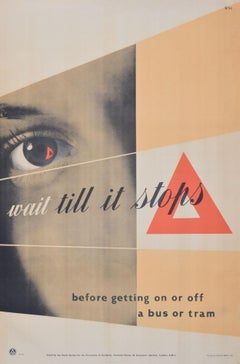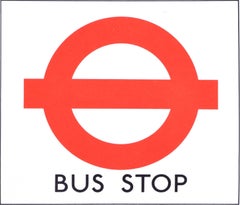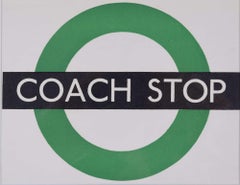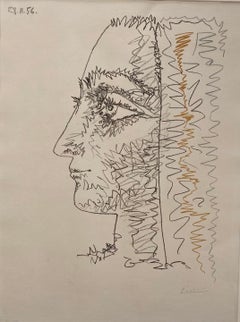Hans Schleger Zero Art
to
5
4
1
3
2
Overall Height
to
Overall Width
to
1
1
5
2
3
5
6,952
3,301
2,514
1,213
5
Artist: Hans Schleger Zero
Wait till it stops before getting on or off a bus or tram original Zero poster
By Hans Schleger Zero
Located in London, GB
To see our other original vintage posters, scroll down to "More from this Seller" and below it click on "See all from this Seller" - or send us a message if you cannot find the poste...
Category
1940s Hans Schleger Zero Art
Materials
Lithograph
Hans Schleger 'Zero' London Transport Bus Stop c. 1970 Original Poster
By Hans Schleger Zero
Located in London, GB
To see our other original vintage travel posters including more pre-war London Transport posters, scroll down to "More from this Seller" and below it click on "See all from this Seller" - or send us a message if you cannot find the poster you want.
Hans Schleger 'Zero' (1898-1976)
London Transport Coach Stop Poster
Screenprint poster c. 1970
16x17.8 cm
Printed for London Transport
These posters were designed to be used as temporary stops when the usual stop required amendment for instance owing to road works or similar events. Printed on paper they were designed to be posted up at the alternative site, possibly over a different sort of stop (bus stop, coach stop, request stop, etc.).
Working with Edward Johnson's special typeface created for London Transport, Hans Schleger - or Zero as he signed himself - adopted the famous roundel used by London Underground for use at Bus Stops. Born in Germany, Schleger was an influential graphic designer. After serving during the First World War, he studied at the Berlin Kunstgewerbeschule, being taught by Emil Orlik. The same year Walter Gropius founded the Bauhaus at Weimar and Schleger learned the same principles of breaking down the barriers between architecture, design, fine art and craft. A firm believer in the Bauhaus principles of simplicity in design and reduction to essentials, these may be seen in the clean lines of the roundel.
In 1924 he moved to New York, applying Modernism to American advertising, and then returned to Berlin in 1929 working for the British advertising agency Crawfords, where he met Edward McKnight Kauffer who introduced him to Jack Beddington the head of advertising at Shell Mex...
Category
1970s Modern Hans Schleger Zero Art
Materials
Lithograph
Hans Schleger 'Zero' London Transport Coach Stop Request Original Poster
By Hans Schleger Zero
Located in London, GB
To see our other original vintage travel posters including more pre-war London Transport posters, scroll down to "More from this Seller" and below it click on "See all from this Sell...
Category
1970s Hans Schleger Zero Art
Materials
Lithograph
Hans Schleger 'Zero' London Transport Coach Stop c. 1970 Original Poster
By Hans Schleger Zero
Located in London, GB
To see our other original vintage travel posters including more pre-war London Transport posters, scroll down to "More from this Seller" and below it click on "See all from this Sell...
Category
1970s Hans Schleger Zero Art
Materials
Lithograph
'Zero' Hans Schleger Grow Your Own Food Surreal Original Vintage Poster
By Hans Schleger Zero
Located in London, GB
To see our other original vintage World War Two public information posters, scroll down to "More from this Seller" and below it click on "See all from this seller" - or send us a message if you cannot find the poster you want.
'Zero' Hans Schleger (1898-1976)
Grow Your Own Food
Lithographic poster c. 1940
Printed by Fosh & Kosh Limited for HMSO
76x51cm
A copy of this poster is in the collection of the Imperial War Museum.
Provenance: the estate of the artist.
In this poster the public are encouraged to Dig For Victory...
Category
1940s Surrealist Hans Schleger Zero Art
Materials
Lithograph
Related Items
Pablo Picasso, "Three Colour Profile", original lithograph, hand signed
By Pablo Picasso
Located in Chatsworth, CA
Pablo Picasso
"Three Colour Profile"
1956
Image Size: 16.5 x 20 inches
Three colour litho on transfer
From the edition of 50 numbered and signed proofs
Picasso Lithographs- Fernand M...
Category
1950s Modern Hans Schleger Zero Art
Materials
Lithograph
Five Greek Poets and a Philosopher
By Cy Twombly
Located in London, GB
Complete set of seven lithographs with embossment, 1978, on Richard de Bas mould-made paper, initialed and numbered in pencil from the edition of 40 verso, printed by Matthieu Studio...
Category
1970s Abstract Hans Schleger Zero Art
Materials
Lithograph
Original Perlach Maccaroni - Spaghetti vintage poster pasta
By Richard Roth
Located in Spokane, WA
An original vintage poster of Perlach Macaroni Spaghetti created by Richard Roth for the German pasta brand, Perlach in the 1940s 1. The poster features an anthropomorphic pasta man...
Category
1940s Art Deco Hans Schleger Zero Art
Materials
Lithograph
H 33.25 in W 24.75 in D 0.05 in
Original "Stufe Pagliero Michele" vintage Italian poster
Located in Spokane, WA
Original Stufe Pagliero Michele vintage Italian antique poster. Archival linen backed and ready to frame. Lithograph from 1929. Excellent condition, ready to frame. A conditio...
Category
1920s Art Deco Hans Schleger Zero Art
Materials
Lithograph
Maurice de Vlaminck - House in Rueil - Original Lithograph
By Maurice de Vlaminck
Located in Collonge Bellerive, Geneve, CH
Maurice de Vlaminck
Original Lithograph
Signed in the plate
1958
Title: House in Beauce
Dimensions: 22 x 27 cm
Reference: Catalogue raisonné Walterskirchen 275
Condition : Excellent
Maurice de Vlaminck (1876 - 1958)
Maurice was three years old when his family moved from Paris to Vésinet. He first pursued the same musical career as his parents, who were both musicians, leaving his home as a trained double-bass player in 1892 to move to Chatou near Versailles. After absolving his military service in Vitré Maurice Vlaminck worked as a musician until he accidentally met André Derain in 1900.
It was Derain who kindled Vlaminck's artistic ambitions. He decided to become a painter and rented an old hut in which he and Derain shared a studio. A crucial turning point in Vlaminck's artistic development was a visit to a van Gogh exhibition...
Category
1950s Impressionist Hans Schleger Zero Art
Materials
Lithograph
H 8.67 in W 10.63 in D 0.04 in
Dendera, Egypt, Dec 7th, 1838: David Roberts' 19th C. Duotone Lithograph
By David Roberts
Located in Alamo, CA
This is an original 19th century hand-colored lithograph entitled "Dendera, Dec 7th, 1838" by David Roberts, from his Egypt and Nubia volumes of the large folio edition, published in...
Category
1840s Realist Hans Schleger Zero Art
Materials
Lithograph
The original Soviet poster from 1968, "American Imperialism is a World Gendarme
Located in PARIS, FR
The original Soviet poster from 1968, "American Imperialism is a World Gendarme (War, Racism, Provocation...)," stands as a vivid example of Soviet propaganda agitation. This poster ...
Category
1960s Hans Schleger Zero Art
Materials
Paper, Lithograph
Tiberias from the Walls: David Roberts' 19th C. Hand-colored Lithograph
By David Roberts
Located in Alamo, CA
This is an original 19th century hand-colored lithograph entitled "Tiberias from the Walls, Saffet (Safed) in the Distance" by David Roberts, from his Egypt and Nubia volumes of the large folio edition, published in London by F. G. Moon in 1841. The lithographs were prepared by Louis Haghe (1806-1885) from drawings and paintings by Roberts. The resultant large folio editions of 'The Holy Land' and 'Egypt & Nubia' are considered among the greatest lithographically illustrated works issued in the 19th century.
This page from Roberts' 19th century publication includes a half-folio hand-colored lithograph of a view of the town of Tiberias and with the town of Safed on the hill in the distance. They lie along the Sea of Galilee...
Category
1840s Realist Hans Schleger Zero Art
Materials
Lithograph
Church of St. Helena, Bethleham: Roberts' 19th C. Hand-colored Lithograph
By David Roberts
Located in Alamo, CA
This is an original 19th century hand-colored lithograph entitled "Church of St. Helena, Bethlehem" by David Roberts, plate 43 in volume II from his Egypt and Nubia volumes of the large folio edition, published in London by F. G. Moon in 1842. The lithographs were prepared by Louis Haghe (1806-1885) from drawings and paintings by Roberts. The resultant large folio editions of 'The Holy Land' and 'Egypt & Nubia' are considered the greatest lithographically illustrated works issued in the 19th century.
The print depicts a view of the interior of the Church of St. Helena (also known as the Church of the Nativity), near the altar. The church is located in Bethlehem, in the West Bank of Palestine. Roberts visited the site between April 4-6, 1839. Men, women and children dressed in colorful traditional local garb are involved in various activities, some praying at the shrine, as part of a religious service, others talking in small groups or resting on the steps.
The church was originally commissioned in 327 by Constantine the Great and his mother Helena over the site that was traditionally considered to be located over the cave that marks the birthplace of Jesus. Constantine was the first Roman emperor to convert to Christianity. He made Christianity the official religion of Rome. He founded Constantinople, which became the most powerful city in the world. The Church of the Nativity site's original basilica was completed in 339, but it was destroyed by fire during the Samaritan Revolts in the 6th century. A new basilica was built 565 by the Byzantine Emperor Justinian...
Category
1840s Realist Hans Schleger Zero Art
Materials
Lithograph
Shepard Fairey Fine Art Screenprint Op-Art Icon Aqua Gradient Street Pop 90s Art
By Shepard Fairey
Located in Draper, UT
In the early ’90s, I fell in love with ’60s psychedelic posters from artists like San Francisco’s Victor Moscoso, Stanley Mouse, Alton Kelley, and Rick Griffin...
Category
2010s Street Art Hans Schleger Zero Art
Materials
Screen
Jonas Wood Gagosain Exhibition Print April 29th, July 19th New York Contemporary
By Jonas Wood
Located in Draper, UT
This print featuring Jersey City Apartment (2019) was produced in 2019, in conjunction with the exhibition Jonas Wood at Gagosian, 555 West 24th Street, New York. The exhibition incl...
Category
2010s Contemporary Hans Schleger Zero Art
Materials
Lithograph
Marc Chagall - Original Lithograph
By Marc Chagall
Located in Collonge Bellerive, Geneve, CH
Marc Chagall
Original Lithograph
1963
Dimensions: 32 x 24 cm
Reference: Chagall Lithographe 1957-1962. VOLUME II.
Condition : Excellent
Marc Chagall (born in 1887)
Marc Chagall was born in Belarus in 1887 and developed an early interest in art. After studying painting, in 1907 he left Russia for Paris, where he lived in an artist colony on the city’s outskirts. Fusing his own personal, dreamlike imagery with hints of the fauvism and cubism popular in France at the time, Chagall created his most lasting work—including I and the Village (1911)—some of which would be featured in the Salon des Indépendants exhibitions. After returning to Vitebsk for a visit in 1914, the outbreak of WWI trapped Chagall in Russia. He returned to France in 1923 but was forced to flee the country and Nazi persecution during WWII. Finding asylum in the U.S., Chagall became involved in set and costume design before returning to France in 1948. In his later years, he experimented with new art forms and was commissioned to produce numerous large-scale works. Chagall died in St.-Paul-de-Vence in 1985.
The Village
Marc Chagall was born in a small Hassidic community on the outskirts of Vitebsk, Belarus, on July 7, 1887. His father was a fishmonger, and his mother ran a small sundries shop in the village. As a child, Chagall attended the Jewish elementary school, where he studied Hebrew and the Bible, before later attending the Russian public school. He began to learn the fundamentals of drawing during this time, but perhaps more importantly, he absorbed the world around him, storing away the imagery and themes that would feature largely in most of his later work.
At age 19 Chagall enrolled at a private, all-Jewish art school and began his formal education in painting, studying briefly with portrait artist Yehuda Pen. However, he left the school after several months, moving to St. Petersburg in 1907 to study at the Imperial Society for the Protection of Fine Arts. The following year, he enrolled at the Svanseva School, studying with set designer Léon Bakst, whose work had been featured in Sergei Diaghilev's Ballets Russes. This early experience would prove important to Chagall’s later career as well.
Despite this formal instruction, and the widespread popularity of realism in Russia at the time, Chagall was already establishing his own personal style, which featured a more dreamlike unreality and the people, places and imagery that were close to his heart. Some examples from this period are his Window Vitebsk (1908) and My Fianceé with Black Gloves (1909), which pictured Bella Rosenfeld, to whom he had recently become engaged.
The Beehive
Despite his romance with Bella, in 1911 an allowance from Russian parliament member and art patron Maxim Binaver enabled Chagall to move to Paris, France. After settling briefly in the Montparnasse neighborhood, Chagall moved further afield to an artist colony known as La Ruche (“The Beehive”), where he began to work side by side with abstract painters such as Amedeo Modigliani and Fernand Léger as well as the avant-garde poet Guillaume Apollinaire. At their urging, and under the influence of the wildly popular fauvism and cubism, Chagall lightened his palette and pushed his style ever further from reality. I and the Village (1911) and Homage to Apollinaire (1912) are among his early Parisian works, widely considered to be his most successful and representative period.
Though his work stood stylistically apart from his cubist contemporaries, from 1912 to 1914 Chagall exhibited several paintings at the annual Salon des Indépendants exhibition, where works by the likes of Juan Gris, Marcel Duchamp and Robert Delaunay were causing a stir in the Paris art world. Chagall’s popularity began to spread beyond La Ruche, and in May 1914 he traveled to Berlin to help organize his first solo exhibition, at Der Sturm Gallery. Chagall remained in the city until the highly acclaimed show opened that June. He then returned to Vitebsk, unaware of the fateful events to come.
War, Peace and Revolution
In August 1914 the outbreak of World War I precluded Chagall’s plans to return to Paris. The conflict did little to stem the flow of his creative output, however, instead merely giving him direct access to the childhood scenes so essential to his work, as seen in paintings such as Jew in Green (1914) and Over Vitebsk (1914). His paintings from this period also occasionally featured images of the war’s impact on the region, as with Wounded Soldier (1914) and Marching (1915). But despite the hardships of life during wartime, this would also prove to be a joyful period for Chagall. In July 1915 he married Bella, and she gave birth to a daughter, Ida, the following year. Their appearance in works such as Birthday (1915), Bella and Ida by the Window (1917) and several of his “Lovers” paintings give a glimpse of the island of domestic bliss that was Chagall’s amidst the chaos.
To avoid military service and stay with his new family, Chagall took a position as a clerk in the Ministry of War Economy in St. Petersburg. While there he began work on his autobiography and also immersed himself in the local art scene, befriending novelist Boris Pasternak, among others. He also exhibited his work in the city and soon gained considerable recognition. That notoriety would prove important in the aftermath of the 1917 Russian Revolution when he was appointed as the Commissar of Fine Arts in Vitebsk. In his new post, Chagall undertook various projects in the region, including the 1919 founding of the Academy of the Arts. Despite these endeavors, differences among his colleagues eventually disillusioned Chagall. In 1920 he relinquished his position and moved his family to Moscow, the post-revolution capital of Russia.
In Moscow, Chagall was soon commissioned to create sets and costumes for various productions at the Moscow State Yiddish Theater...
Category
1960s Surrealist Hans Schleger Zero Art
Materials
Lithograph
Hans Schleger Zero art for sale on 1stDibs.
Find a wide variety of authentic Hans Schleger Zero art available for sale on 1stDibs. If you’re browsing the collection of art to introduce a pop of color in a neutral corner of your living room or bedroom, you can find work that includes elements of green, red and other colors. You can also browse by medium to find art by Hans Schleger Zero in lithograph and more. Much of the original work by this artist or collective was created during the 20th century and is mostly associated with the Surrealist style. Not every interior allows for large Hans Schleger Zero art, so small editions measuring 8 inches across are available. Customers who are interested in this artist might also find the work of Hanna Kay, Mayo (Antoine Malliarakis), and Francis de Saint-Genies. Hans Schleger Zero art prices can differ depending upon medium, time period and other attributes. On 1stDibs, the price for these items starts at $93 and tops out at $1,237, while the average work can sell for $94.






